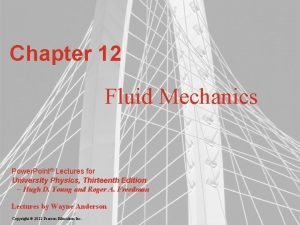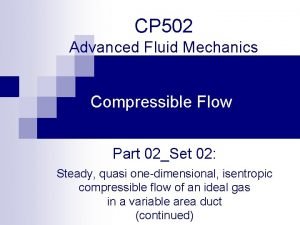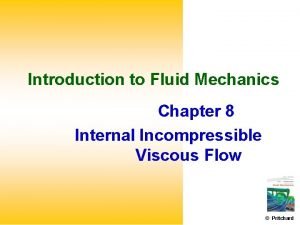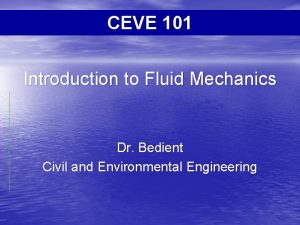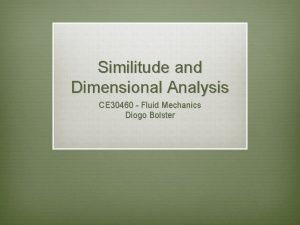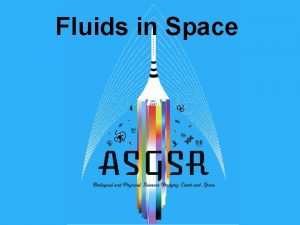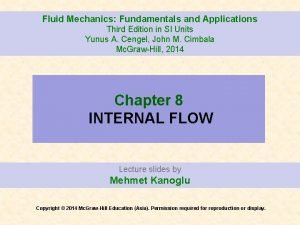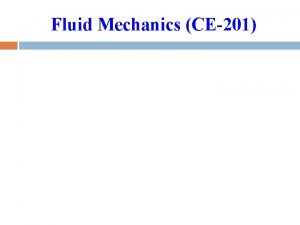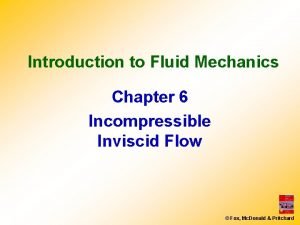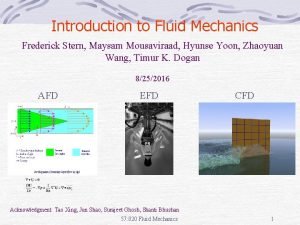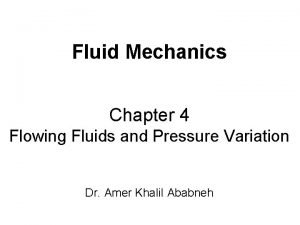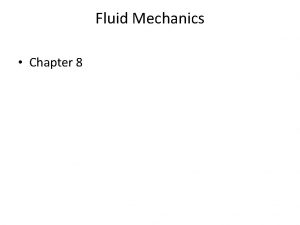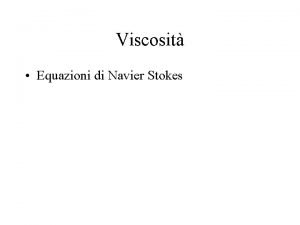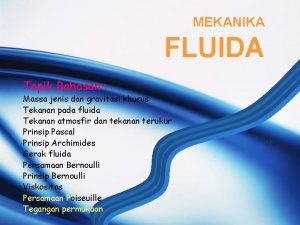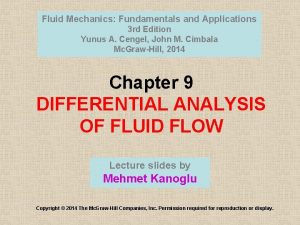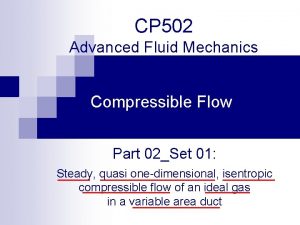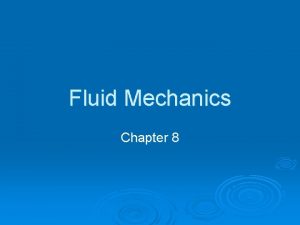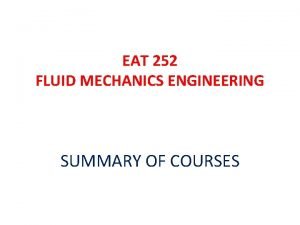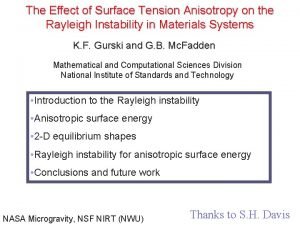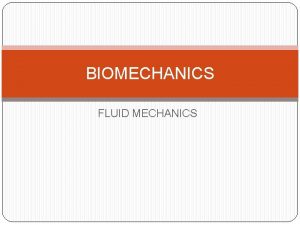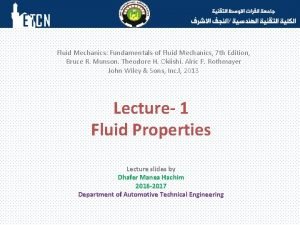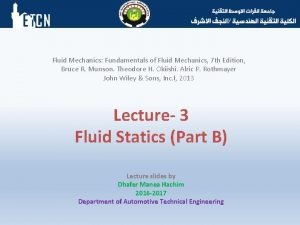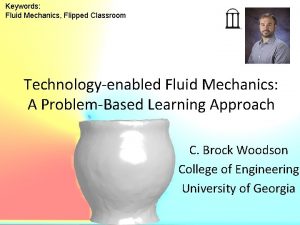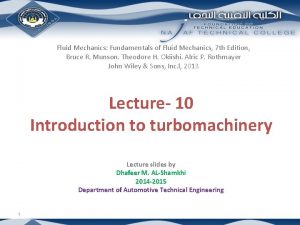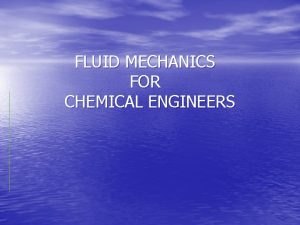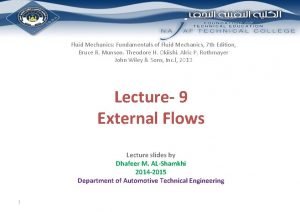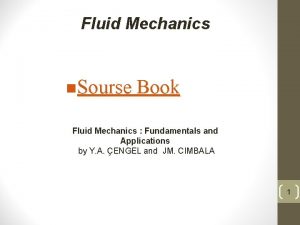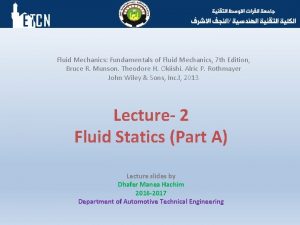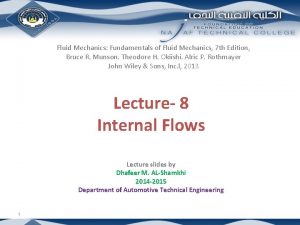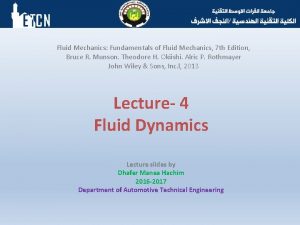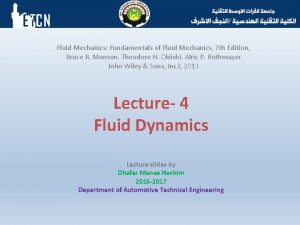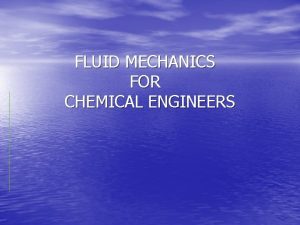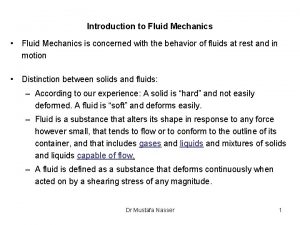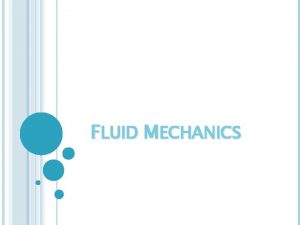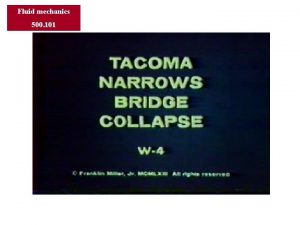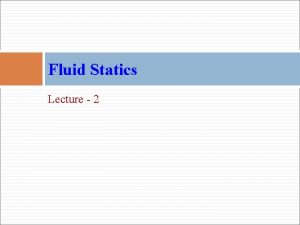Overview of Fluid Mechanics Fluid mechanics is the



























- Slides: 27

Overview of Fluid Mechanics • Fluid mechanics is the study of fluids at rest (fluid statics) or in motion (fluid dynamics), as well as solid/fluid interactions. • There are two types of fluids : (1) non-compressible, e. g. , liquids ; and (2) compressible, e. g. , gases. • Fluids are made up of molecules that are more widely spaced than the molecule size, and these molecules are not fixed in a lattice (as in solids)but move freely relative to one another : thus a fluid has a volume but no shape. • Unlike solids, fluids can not resist any shear force or shear stress without moving. All fluids have viscosity that causes friction when the fluid is set in motion. • Viscosity is a measure of the fluid’s resistance to shear when the fluid is in motion, therefore it is necessary to have a driving pressure to make a fluid flowing in a conduit, a channel, or, as in the case of fluidics, system of conduits.

Viscosity of Fluids • Fluids can be put to motion by even a slight shear force. • Mathematically q is shear strain, t is shear stress and m is dynamic viscosity or viscosity.

- A Newtonian fluid is the one for which

-In a Newtonian fluid one can show that where u(y) represents the velocity of the fluid at a distance y from the stationary state at the bottom plate.

Definitions • Stream line : is the trace of any point in a moving fluid. • A stream tube : is made up by a bundle of streamlines through all points of a closed curve. • Control volume (C. V. ) and control surface (C. S. ) : as fluids do not have fixed shapes of their own, it is not possible to define their volumes as we do with solids. Consequently, the term C. V. is adopted for computational purposes. C. V. is selected in such a way that the flow properties, e. g. , velocities, can be evaluated at locations where the mass of the fluid crosses the surface of this volume which is called C. S. • Laminar flow : is a gentle flow that follows the streamlines • Turbulent flow : is a violent flow that does not follow any traceable pattern. • Reynolds number, Re, : determine the fluid flow pattern and defined as Re=r. Lv/m, where r is mass density, v is speed, and L is a characteristic length. • Laminar flow occurs for Re < 10 to 100 for compressible fluids and Re<1000 for incompressible fluids.

Mathematical Models of Fluid Dynamics • An actual fluid is made up of molecules with empty space between them. In general, when one establishes the mathematical models, fluid is assumed to be a continuous medium- a continuum. However, mathematical models taking into account the statistical behavior of the individual molecules have been developed and are necessary for the study of rarefied gases. • There are five basic variables in fluid flow, three components of velocity and two thermodynamic properties. • In fluid dynamics we are concerned with four basic laws: – Conservation of mass – Newton’s second law of motion – Conservation of energy – Second law of thermodynamics • These laws apply to a fixed quantity of matter (system) which maintains its identity as it undergoes a change in conditions.

Conservation of Mass • If r is the mass density, V and A indicate volume and area, respectively, and C. V. designates control volume fixed in space and bounded by the control surface (C. S. ), the integral equation is of the form: • However, the differential equation for mass conservation is

- For steady flow (∂r/∂t=0) : - For a steady flow of a fluid entering section 1 and leaving sections 2 and 3 : - For a single pipe with no third exit :

Newton’s Law/Linear Momentum : Integral Form • For a surface force (pressure and shear), Fs, and body force density, B, the integral form is • For steady flow and B=0 • If r and v are uniform and for a one entrance 1 and exit 2 then

Newton’s Law/Linear Momentum : Differential Form • The stress tensor sij : • Euler equations in cartesian tensor notation : • The operator D/Dt is called the substantial or material derivative and in vector form

Momentum Equations for Frictionless Flow • For frictionless flow: • In general form the Euler equations • Sine v//dl, • For a steady state and a gravitational potential • For incompressible flow : is perpendicular to dl and hence for a frictionless flow:

Newton’s Law/Angular Momentum • Use the linear momentum equation in a cross product with the position vector r to get

- If we choose to write the equation for the z-axis, the net torque in the z-axis, Tz, is - If the fluid enters the volume at an area A 1 and leaves at an area A 2, over which r, v and cosa are uniform

Turbine Compressor

Kinematics In Fluids • The translation rate is given by the velocity vector v and corresponds to the velocity of the mass center of infinitesimally small fluid element. • The rotation rate vector (angular velocity), W, is defined at a point and is precisely defined for infinitesimal fluid element as

- w is known as the vorticity. -Generally, the viscous or frictional effects in a fluid give rise to vorticity. - A fluid flow in which W = 0 is known as irrotational flow.

- The shear strain rate in the ij plane, gij, is the rate at which the two sides close toward each other. - The dilatation, f, which represents the rate (per unit volume of fluid) of expansion or contraction of a small system of fluid.

The Navier-Stokes Equations • The Navier-Stokes equations of motion for a viscous Newtonian fluid l is a second coefficient of viscosity. • For an incompressible fluid • In terms of vorticity and for incompressible fluid

- The energy equation for fluid flow is a statement of the first law of thermodynamics - The second law of thermodynamics for fluid flow takes the form

Incompressible Fluid Flow in Microconduits • It is observed that the velocity of a fluid flowing in a conduit increases toward the center of the conduit partly due to the nonslip boundary at the conduit wall : the nonslip boundary condition is principally due to the maximum friction between the fluid and the conduit wall. • Another phenomenon is the spherical surface of a droplet of viscous fluid on a flat surface : this is the case for very small droplets. • The formation of droplets is due to the existence of a tensile force in the spherical surface of the droplet which exceeds the hydrostatic pressure in the contained fluid : the tensile force is called the surface tension of incompressible fluids and it is related to cohesion forces of molecules. • Surface tension al; so exists between the fluid and solid contacting wall of the conduit, but is not a dominant force under normal conditions. • The combined effect of frication at fluid/conduit wall and surface tension in fluid makes the pressure driving fluid flow nonuniform. Such nonuniformity is what causes the well-known capillary effect: this change in pressure must be accounted for in Navier-Stokes equations

Surface Tension • Surface tension is given as • For water • The pressure change, Dp, due to surface tension is

- We may estimate the total pressure change in a free-standing liquid in a small tube with diameter d ~2 a to be the sum of the preceding pressure changes as

The Capillary Effect • The capillary effect is related to the surface tension of the fluid and the size of the conduit in which the fluid flow. • An obvious capillary phenomenon is the rise of fluid in a minute open-ended tube when one of its ends is inserted into a volume of a liquid.

Laminar Fluid Flow in Circular Conduits • The existence of friction in a fluid flowing in a conduit results in pressure drop. The equivalent “head” loss due to friction in a circular conduit of diameter d and length L is accounted for by the Darcy. Weisbach relation. • Using as , the shear stress at the conduit wall, tw, may be found with y = d/2=a • For a laminar flow

Laminar Flow in a Circular Conduit • For flow in a conduit of diameter d=2 a and length L, the volumetric flow, Q, the pressure drop Dp, and head loss, hf, l are • A hydraulic diameter, dh, for the conduit is defined as • • For a circular x-section dh=d For a rectangular x-section o width w and height h

Micropumping • From the preceding discussion it is clear that pressure drop Dp is inversely proportional to a because of surface tension and is inversely proportional to a 4 due to friction in laminar flow. • Conventional pumping methods for volumetric flow are, therefore, non feasible in MEMS. • An alternative pumping method is electrohydrodynamic pumping with electro-osmosis and electrophoretic methods. • However a more effective micropumping technique is piezoelectric pumping.

Capillary tube for microflow Microflow in wave stream in a capillary tube
 Fluid kinematics definition
Fluid kinematics definition Solute definition
Solute definition Fluid statics deals with fluid at rest
Fluid statics deals with fluid at rest Hypoosmotic
Hypoosmotic Fluid statics deals with fluid at rest
Fluid statics deals with fluid at rest Movement of body fluids
Movement of body fluids Fluid compartments in the body
Fluid compartments in the body Horseshoe dullness volume
Horseshoe dullness volume Synovial fluid
Synovial fluid Fluid mechanics powerpoint
Fluid mechanics powerpoint Mach number in fluid mechanics
Mach number in fluid mechanics Fluid mechanics chapter 8 solutions
Fluid mechanics chapter 8 solutions Fluid mechanics 101
Fluid mechanics 101 Dimensionless groups in fluid mechanics
Dimensionless groups in fluid mechanics Fluidmechanics 101
Fluidmechanics 101 Fluid mechanics fundamentals and applications
Fluid mechanics fundamentals and applications Specific weight to density
Specific weight to density Energy equation in fluid mechanics
Energy equation in fluid mechanics Frederick stern
Frederick stern Fluid mechanics bernoulli equation
Fluid mechanics bernoulli equation Mass density in fluid mechanics
Mass density in fluid mechanics Sprittles
Sprittles Fluid mechanics topics
Fluid mechanics topics Fluid mechanics fundamentals and applications
Fluid mechanics fundamentals and applications Cp in fluid mechanics
Cp in fluid mechanics Buoyancy force in fluid mechanics
Buoyancy force in fluid mechanics Fluid mechanics summary
Fluid mechanics summary Dimension of surface tension
Dimension of surface tension









